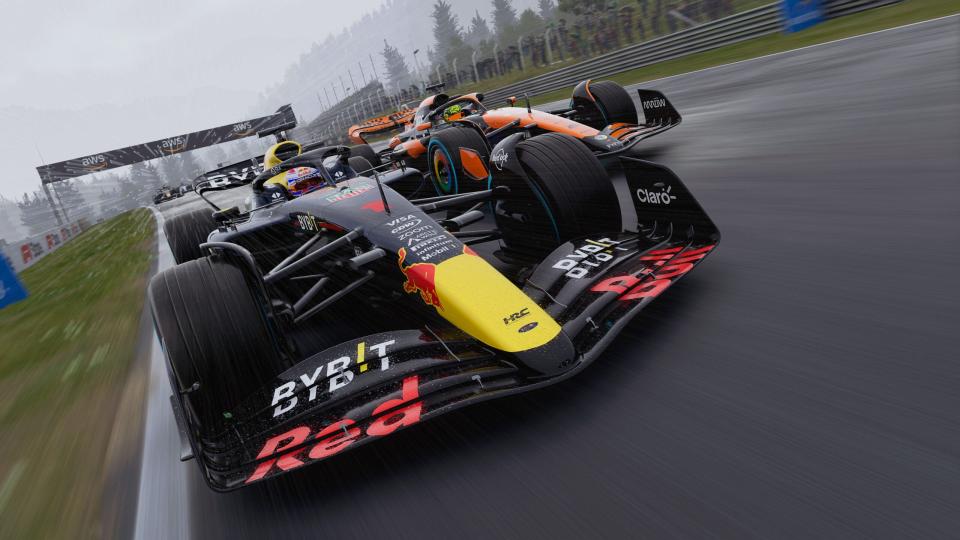EA Sports F1 Is Sticking With the Ego Game Engine—And That's a Good Thing

When F1 24 was ramping up for its reveal some weeks ago, a particularly vocal subset of the official Formula 1 game's community seized on a critique that's not uncommon in modern gaming. See, the game engine behind the title, Ego, has deep roots, having powered every Codemasters F1 entry back to the first in 2009. Ego's legacy is often blamed for these titles looking or playing similarly year after year, but the reality is that the technology has evolved enormously over the last decade and a half, and the development team has no intention of ditching it now—nor should they.
Indeed, EA Sports' official F1 games will continue to be built on Ego for the foreseeable future rather than moving to third-party technology like Unreal Engine, F1 24 Senior Creative Director Lee Mather told The Drive on the paddock of the Miami Grand Prix.
"I think what people don't realize is because we publicized the move to a different version of Ego in 2015—we're not on that version still. We have iterated on it hundreds of times since then," Mather said, before calling out the considerable progress the franchise has seen on the graphical side alone.
"So if you look at what we've got now from a graphics standpoint, we wouldn't have had [Dynamic Diffuse Global Illumination] back then. We didn't have ray tracing, we didn't have ray-cast shadows. All of those things are additions that are right up to date, cutting edge. We got 4K [resolution and] 60 [frames per second], we got 120 Hz on [Xbox] Series X and PS5."

Mather's been building F1 games at Codies since the company's very first. He reflects that because F1 2015 was publicized as running "Ego 4.0," and the studio stopped incrementing the version number after that point, that's led to the impression that the platform the game was built on wasn't evolving—something that clearly wouldn't hold true for anyone going back and loading up 2015, then comparing to last year's F1 23. Mather says someone on the dev team actually counted the changed or added lines of code since that initial 4.0 release, and though he couldn't remember the exact number during our short chat under the sweltering Florida sun, the director said the difference was "significant."
Digging deeper, fans should be pleased that Codies is still committed to Ego for this franchise. We all saw the fallout of EA Sports WRC moving from Ego, as Dirt Rally 2.0 used, to Unreal Engine 4 in pursuit of lengthier stages. The result was a game that still handled excellently but looked comparatively poor and ran infinitely worse. In fact, I'd go so far as to say at launch, EA Sports WRC was unplayable on PC, owing to the regretfully uncommon phenomenon of Unreal Engine's shader compilation stutter. Codemasters was always a bastion of racing games that played smoothly and consistently, and F1 is able to sustain that reputation precisely because it utilizes the studio's own tech, which is laser-focused on open-wheel circuit racing these days.

"[Ego] gives us great versatility," Mather told me. "We can pick and choose what tech benefits Formula 1, because there's no point taking tech that's no use to us. We want stuff that benefits the F1 game, because it's the F1 engine. And it's the same with the physics—we can pick and choose the components that work for Formula 1, not for other formulas that we don't need to worry about."
That's exactly what you'd hope for from a simulation at any level, whether we're talking about the official F1 title or iRacing. There's a reason why Gran Turismo and Forza Motorsport run on their own proprietary engines as well, rather than Unreal. These are complicated games with highly specialized requirements. Just consider the specific enhancements Codemasters is touting for F1 24's physics.
"We started iterating on [the handling model] straight off the back of [F1] 23," Mather said. "And it wasn't just refining what we had, it was replacing large chunks of technology—so the suspension was redone to bring in the kinematics, aero was redone to take into consideration the ride height of the car more effectively, and the DRS was completely redone."
In the end, if there's any skepticism of what's truly new in a game like F1 24, it's ultimately down to the fact that these are annual releases simulating a sport that changes in only incremental ways from year to year, just like any other major sport. From a technological perspective, Ego has evolved to meet (or, at least, attempt to meet) the challenges each new installment presents. Personally, I'm looking forward to seeing how it drives with those physics improvements when F1 24 launches on May 31.
Got tips? Send 'em to tips@thedrive.com

 Yahoo Autos
Yahoo Autos 